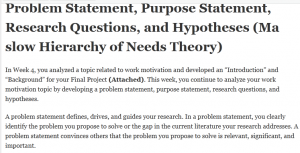Problem Statement, Purpose Statement, Research Questions, and Hypotheses (Ma slow Hierarchy of Needs Theory)

In Week 4, you analyzed a topic related to work motivation and developed an “Introduction” and “Background” for your Final Project (Attached). This week, you continue to analyze your work motivation topic by developing a problem statement, purpose statement, research questions, and hypotheses.
A problem statement defines, drives, and guides your research. In a problem statement, you clearly identify the problem you propose to solve or the gap in the current literature your research addresses. A problem statement convinces others that the problem you propose to solve is relevant, significant, and important.
In a purpose statement, you answer the question: What is the purpose of your research? To craft a clear and concise purpose statement, it is often recommended you start with the following unfinished sentence: The purpose of this study is to. . . .
In addition to preparing a problem statement and purpose statement, you must formulate a set of research questions, generate hypotheses, and identify independent and dependent variables. Please refer to the Final Project Template for additional information.
The assignment (2–3 pages):
Develop a “Problem Statement” (1–2 paragraphs) for your Final Project that includes:
- The research problem
- Evidence of consensus that the problem is current, relevant, and significant to the discipline
- An explanation of how the problem statement addresses a meaningful gap in the current research literature
Develop a “Purpose Statement” (1–2 sentences) for your Final Project that includes:
- The research paradigm (quantitative/qualitative/mixed) and specific design/tradition within paradigm
- The study intent (such as describe, compare, correlate, explore, develop, etc)
- The independent, dependent, and covariate variables (quantitative studies) or concept/phenomenon (qualitative studies)
Develop research questions (1 page) and hypotheses (1 page):
- State the research questions.
- Describe what constructs you might measure and explain how you might measure them.
- State the hypotheses by using appropriate population parameters and statistical notation. (Use of an equation editor makes typing hypotheses easy.)
- For quantitative studies, state the null and alternative hypotheses that identify the independent and dependent variables being studied and the association being tested
Support your assignment with specific references to all resources used in its preparation. You are to provide a reference list for all resources, including those in the Learning Resources for this course.